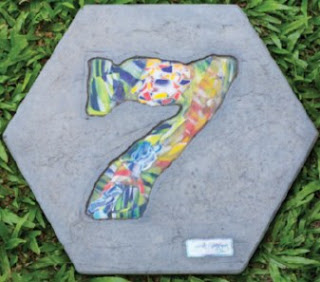 |
| To soften the space, the new garden bed was subtly outlined with gently curving aluminium edging |
Fresh, funky and family friendly, this rear garden provides a taste of the tropics.
To create a backyard that perfectly captures the personality and lifestyle of
the owners, sometimes you need to think outside the square, or in this case, the rectangle. When presented with a long and narrow rear garden comprised of a new lawn and several existing, highly angular features I will bring everything together through a lush, tropical plantscape, which would “green” the rectangular space and soften the hard lines.
To create a backyard that perfectly captures the personality and lifestyle of
the owners, sometimes you need to think outside the square, or in this case, the rectangle. When presented with a long and narrow rear garden comprised of a new lawn and several existing, highly angular features I will bring everything together through a lush, tropical plantscape, which would “green” the rectangular space and soften the hard lines.
 |
| Plants of different heights were used to create the layered effect expected of a tropical garden. |
This was made possible through the tropical garden concept, which offered a relaxed and less formal solution for producing a coherent, holistic design. However, this approach was not without its challenges. As the majority of the established trees were to stay, this meant we had to be cautious of potential root competition for new plantings. Also, tropical planting usually requires the creation of deep garden beds to get maximum layering but, in this case, the owners wanted the lawn to be as large as possible.
 |
| So the family’s son had somewhere to play, creating as large a lawn as possible was a main priority. |
A mix of native and exotic plants with striking foliage, such as cordylines, birds nest fern, golden cane palms, elephant’s ears, turf lily, slender weaver’s bamboo and tiger grass. These were then interspersed with flowering plants, such as white calla lilies, clivias, Magnolia ‘Little Gem’ and various gingers, which off er seasonal splashes of color, contrast and interest. As ground cover, mondo grass and native violets were employed. The combination of foliage and floral-centric plants worked together to produce a range of heights, colors and textures, creating a richly layered tropical jungle effect.
 |
| Contemporary with a tropical twist, this newly landscaped backyard suits adults and children alike. |
The plants wrap around the perimeter of the garden, in the centre of which is a large, level lawn that provides a safe and open space where the owners’ son can play. While the rectilinear shape of the lawn offered some resistance to the creation of a casual tropical ambience, curved aluminium garden edging was incorporated along one side to soften the look and gently contrast the angularity of the deck and timber edging. To turn the deck into a great space for entertaining and bring some of the colors from the garden to the dining space, it was furnished with an urban-grey table made out of glass-reinforced concrete (GRC) and teamed with funky chairs in luscious lime. A contemporary tropical feel was also encouraged into the garden with the potted frangipani and cordyline that flank the dining area and help to define the adult entertaining space.
 |
| The deck was furnished with a contemporary table made of GRC and fun dining chairs in lime green. |
At the far end of the garden, a stunning laser-cut Corten steel feature screen was installed, providing a focal point that can be enjoyed from the deck or when looking out from inside the two-storey home. The screen, which is backlit for added effect, was also installed to add warmth and textural interest to an otherwise soft-scaped area.
 |
| The existing timberedged beds were given a new lease on life with a flourishing new plant palette |







































